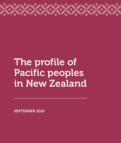Pasifika navigation
- Home
- Widgets
- Effective teaching
- Engaging with parents
- Tapasā
- Talanoa Ako - Pacific Talk About Education and Learning (TA PTEL)
- Pacific Education 2020–2030
- LEAP
- Pacific languages
- About this site
- Resources
- Research
New Zealand has a large and diverse Pacific population, of whom almost two thirds are born in New Zealand. The population of Pacific children and young people who can attend early childhood education and schooling is significant and increasing, and predicted to reach 20 percent of the school population by 2050

In 2016 Pasifika Proud published The profile of Pacific peoples in New Zealand. The data-based paper about Pacific peoples includes statistics from a range of publicly available data sources about their participation and experiences of education and health.
The term Pasifika encompasses the cultural and linguistic diversity within the Pasifika population.
Pasifika (sometimes spelt Pasefika) is used to refer to the people, cultures, and language of Pacific groups (including: Sāmoa, Tonga, the Cook Islands, Niue, Tokelau, Tuvalu, and other smaller Pacific nations) who are now living in New Zealand.
Previously, New Zealand governed most of these Pacific nations. Some, notably Niue and the Cook Islands, retain close administrative ties with New Zealand although they are now independent. Tokelau remains a dependent territory of New Zealand.
Achievement data for all learners has been improving over the last decade, with Māori and Pacific learners showing the greatest gains (Ministry of Education, 2020). However, Pacific learners are still experiencing significant disparities in achievement.
In the past, this underachievement of Pasifika students was often attributed to a lack of proficiency in English combined with differing cultural norms. Sometimes a student’s first language was regarded as "interfering" with the learning of a second language, a concept known as a subtractive view of bilingualism. In addition, deficit thinking about Pasifika learners bilingualism often affected teacher expectations.
Research shows that the degree to which Pacific languages and cultures are valued in teaching and included in their learning determine whether they succeed.
Linguistic Interdependence highlights the interconnectedness of language learning – specifically, how knowledge of a learner's first language supports the development of a second language or target language.
Leveraging Linguistic Interdependence effectively for students can only be achieved in "additive bilingual" programs, which specifically value and include all the languages students know, as well as aiming for bilingualism and biliteracy for students by program end.
Research findings over the last 60 years have demonstrated that bilingual students in additive bilingual contexts have clear and consistent advantages over monolingual speakers in: cognitive flexibility, communicative sensitivity, and metalinguistic awareness ( May, 2020).
LEAP (Language Enhancing the Achievement of Pasifika) and the Va‘atele Framework – both make specific links to additive bilingualism and language learning for Pasifika bilingual students.
Key messages from research
- Implementing evidence-informed good practice, based on culturally responsive pedagogy in particular, significantly enhances outcomes for Pacific learners’ wellbeing and achievement
- Efforts need to be informed by the evidence about what works – too often well-intentioned efforts are ineffective and can do harm
- Racism in both overt and less conspicuous forms pervades the education system and is a significant barrier to the wellbeing, belonging and achievement of Pacific learners and their families
- Low expectations and incorrect assumptions about the capabilities and motivations both of Pacific learners and their families impede the development of good relationships and the use of effective teaching strategies
- Inequitable opportunities in many different forms accumulate across the school years for Pacific learners
- Sharing innovation to improve achievement requires strong leadership and significant sustained resource.
Find out more about the family and community backgrounds of your students. You can do this in various ways, including through group and individual work.
Use these suggestions to start the discussion in your classroom.